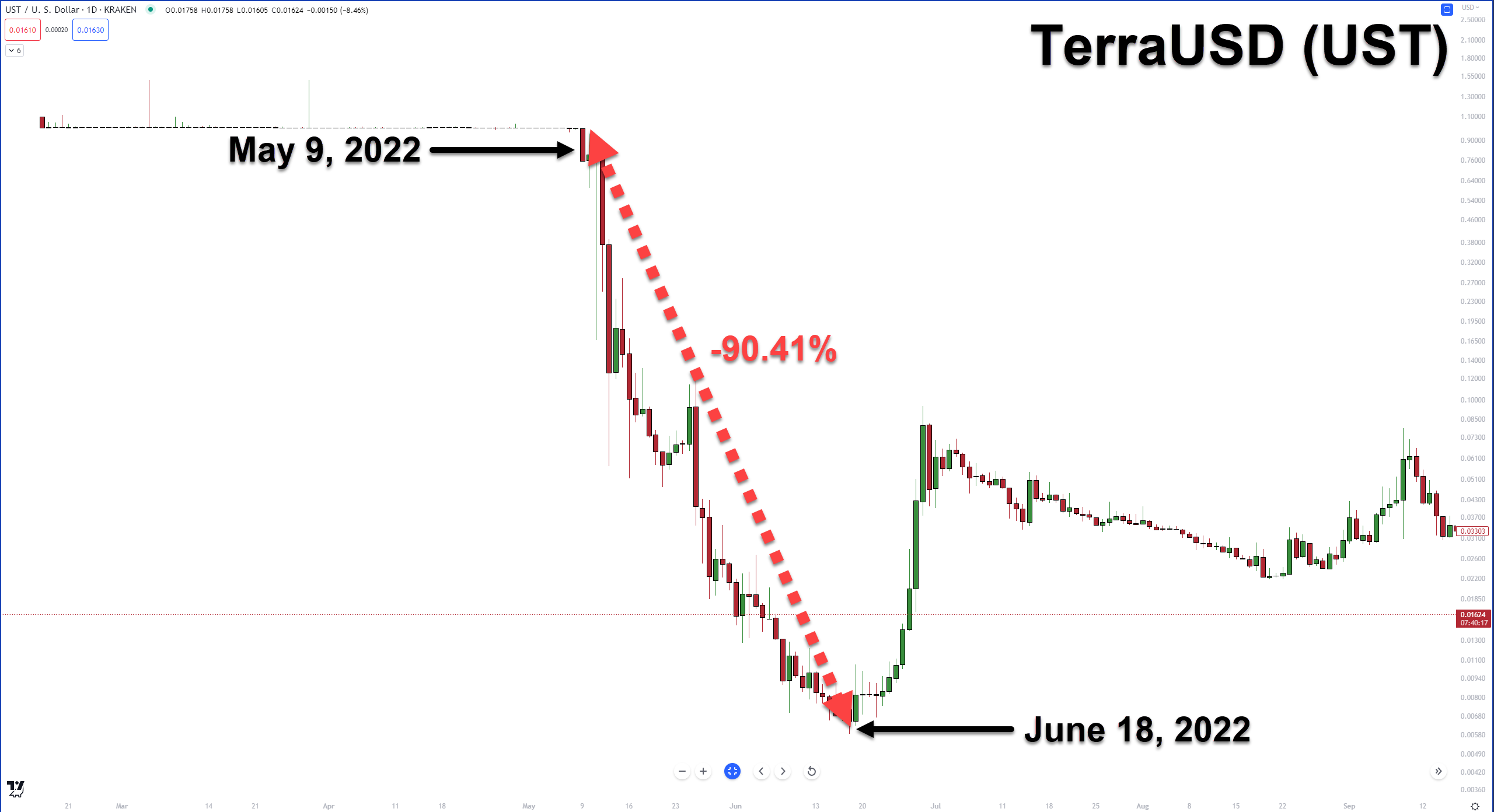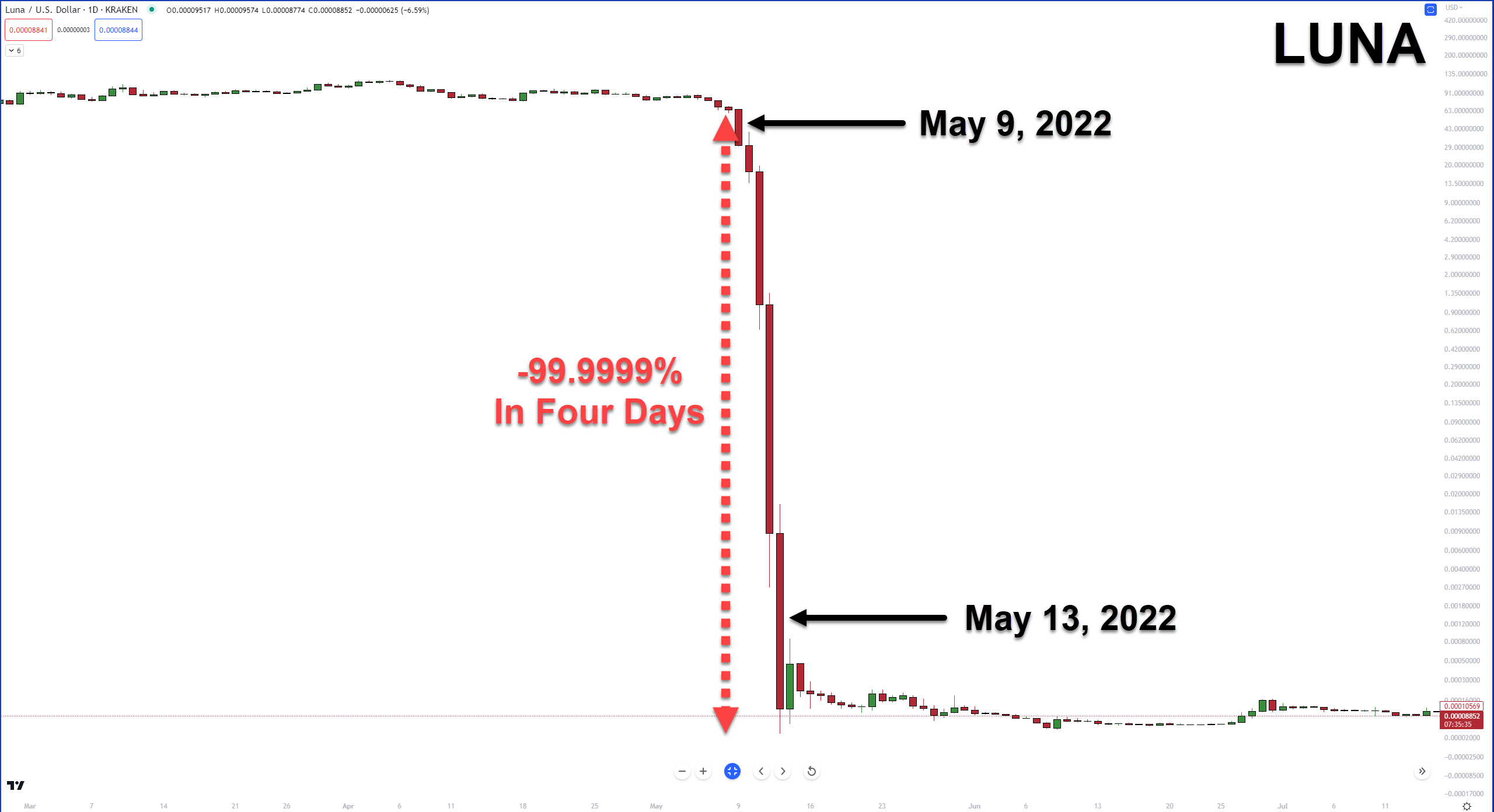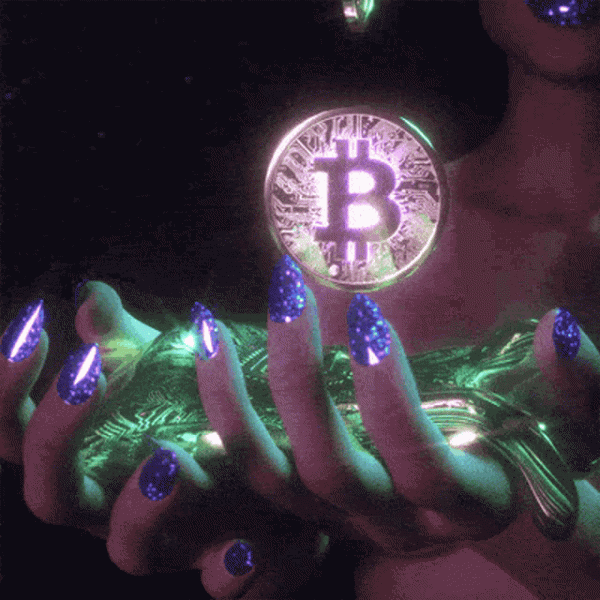Red all over as we approach the one-year anniversary of Terra’s collapse. 🟥
Tomorrow marks the one-year anniversary of the beginning of the end for Terra’ls LUNA, UST, and Do Kwon the con.
We’ll look at what happened last year along with Binances wild weekend, Argentina’s crypto crackdown, and a Crypto 101 article on Bitcoin ordinals.
Here’s how the market looked at the end of the trading day:
| Cosmos (ATOM) | $10.95 | 0.13% |
| Monero (XMR) | $153.72 | -1.92% |
| TRON (TRX) | $0.068 | -2.01% |
| BNB (BNB) |
$317.78
|
-2.03% |
| Cardano (ADA) |
$0.371
|
-2.54% |
| OKB (OKB) | $44.37 | -2.84% |
| Ethereum (ETH) | $1,864 | -2.89% |
| Internet Computer (ICP) | $5.48 | -2.95% |
| Ethereum Classic (ETC) | $18.46 | -3.62% |
| Bitcoin (BTC) |
$27,946
|
-3.67% |
| Altcoin Market Cap |
$580 Billion
|
-1.76% |
| Total Market Cap | $1.122 Trillion | -2.01% |
May 9, 2022, is regarded as the beginning of the end of Terra’s $LUNA and its stablecoin (lol) $UST.
They say a picture is worth a thousand words. The charts below show what happened a year ago:
TerraUSD ($UST)

LUNA ($LUNA)

10 Horrifyingly Amazing Facts about Terra’s and UST’s Collapse
- The Speedy Descent: Terra’s collapse was alarmingly swift, with UST’s value plummeting within mere weeks, shocking the crypto community and leaving many in disbelief.
- A $30+ Billion Nightmare: At its peak, Terra’s market cap exceeded $1 billion, making its eventual collapse a colossal financial catastrophe for countless investors. FTX may get all the news, but Terra’s collapse was waaaaaaay worse.
- A Seismic Shift: Prior to the collapse, Terra had a top-10 spot among cryptocurrencies. Its rapid descent sent shockwaves through the market and led to a reordering of the crypto hierarchy.
- Doomed DeFi Projects: The collapse didn’t just affect Terra and UST. Multiple DeFi projects built on the Terra ecosystem were dragged down with it, leaving devastation in their wake.
- The Peg That Broke: UST’s inability to maintain its peg to the US dollar was a central horror in this tale, as its stability had been a cornerstone of Terra’s ecosystem and a major selling point for investors.
- Community Fragmentation: The collapse of Terra saw its once-united community fracture into factions, with some desperately holding on to hope while others jumped ship, creating an environment of chaos and discord.
- Governance Gone Wrong: The Terra collapse highlighted the importance of effective governance in the crypto world. The struggle to coordinate efforts to save the ecosystem only accelerated its decline.
- The Impact on DeFi: Terra’s downfall sent ripples throughout the entire DeFi space, with the collapse of such a prominent project casting doubt on the stability and reliability of other DeFi projects.
- The Role of Market Turbulence: External market factors played a significant part in Terra’s demise, demonstrating the vulnerability of even well-established projects to broader economic fluctuations.
- The Resilience of Crypto: Despite the horrifying collapse of Terra and UST, the overall cryptocurrency market continued to forge ahead, reflecting the resilience and adaptability of the space in the face of adversity.
I requested ChatGPT to compose a poem reflecting LUNA’s and UST’s downfall, incorporating the role of Do Kwon the Con.
All in the vein of the iconic Remember Remember the 5th of November.
Crypto
Binance’s Wild Weekend
Binance, the world’s largest crypto exchange, caused some headaches and FUD over the weekend. 🫣
Binance suspended Bitcoin (BTC) withdrawals twice within 12 hours, leaving users hanging and scratching their heads.
In a nutshell, the congestion in Bitcoin’s network is mostly due to Bitcoin ordinals – or Bitcoin NFTs. Check out our Crypto 101 on what Bitcoin NFTs are.
Suspension #1: Network Congestion Chaos 🚧
The first suspension came as a result of “network congestion,” with Binance citing “a large backlog of Bitcoin withdrawals” as the culprit. This led to transaction delays for users and a flood of concerned comments on social media.
In response to the chaos, Binance swiftly transferred a jaw-dropping 44,000 BTC (valued at over $1.7 billion!) between its wallets, aiming to optimize transaction efficiency. After this massive shuffle, Binance resumed withdrawals. 🚶♂️
CZ took to Twitter to address what was going on:
4. There are some FUD about BTC withdrawal issues. Here is why. Bitcoin network fees are fluctuating, 18x in a month. 🤷♂️🙏
(the screenshot is a google translate version) pic.twitter.com/iYcEx22xMJ
— CZ 🔶 BNB (@cz_binance) May 8, 2023
Suspension #2: Another Round of Withdrawal Woes ⛔
But the celebration was short-lived! Mere hours later, Binance halted BTC withdrawals again, with no official explanation provided. Users were left in limbo, wondering, again, what the hell was/is going on.
Finally, after a suspenseful 12-hour rollercoaster, Binance restored BTC withdrawals for the second time. 🙏
According to Binance’s official Twitter, all pending Bitcoin withdrawal transactions have been processed:
All pending $BTC withdrawal transactions have now been processed.
Once again, thank you for your patience and our team is already implementing solutions to make sure this doesn't happen again. https://t.co/tY7S8R3U9d
— Binance (@binance) May 8, 2023
We’ll keep you updated as this story develops.
The Central Bank of Argentina has dropped the hammer on financial payment services, barring them from offering crypto transactions as part of an effort to limit digital assets’ exposure to the nation’s payment system. This restriction encompasses fintech companies and financial firms alike, substantially reducing the country’s crypto transaction capabilities.
In a statement, the Bank of Argentina points out that payment service providers cannot offer crypto services on their platforms or apps, adding that anyone interested in crypto transactions “must carry out the operations on their own.” With the fintech chamber of Argentina opposing the decision and pushing for its reversal, the country’s dynamic stance on crypto continues to evolve amidst an ongoing economic crisis.
The move isn’t a major surprise, though. Argentina has made several types of bans on how it’s citizens can use or purchase the U.S. Dollar in the past. 📖
Before we dive into Bitcoin Ordinals/NFTS, we need to understand what an ordinal is:
What are Bitcoin ordinals? The technical definition: 🗒️
Bitcoin ordinals are numbers assigned to Bitcoins in the order they’re mined or created.
These ordinal numbers are unique identifiers that can help track the history of each individual Bitcoin.
When Satoshi Nakamoto mined the first-ever Bitcoin block (known as the Genesis Block) in 2009, the first 50 Bitcoins came into existence.
These initial coins were assigned ordinal numbers, starting from 1 to 50. As more Bitcoins were mined, the ordinal numbers continued to grow sequentially. 🚀
The Birth of Bitcoin Ordinals/NFTs 🧪
Inspired by Ethereum’s NFT space that soared in 2021, programmer and artist Casey Rodarmor created Bitcoin ordinals to offer a unique experience on the Bitcoin blockchain.
These immutable on-chain collectibles use ordinal theory to assign individual identities to satoshis, allowing them to be tracked, transferred, and given meaning. 💡
How Do Bitcoin Ordinals Work? 🤔
In a nutshell, Bitcoin ordinals are a numbering scheme for satoshis, numbering them based on the order of mining.
Ordinal theory treats satoshis as atomic units on the Bitcoin network, which can be inscribed with digital content to create Bitcoin ordinals.
The potential of ordinal theory even extends beyond NFTs, with use cases like attaching security tokens, accounts, or stablecoins to satoshis. 🧬
Mining and Trading Bitcoin Ordinals 🎨
Mining, minting, or inscribing Bitcoin ordinals can be technically complex, but with tools like Gamma and the Ordinals Bot, users can upload content to create their own Bitcoin ordinal.
While trading is still in the early stages, tools like Ordinals Wallet, Hiro, and Xverse facilitate buying and selling ordinals. As demand grows, expect a more mature ecosystem and user-friendly tools to emerge. ⚒️
Bitcoin Ordinals vs. Traditional NFTs 💎
While there are similarities between Bitcoin ordinals and traditional NFTs, several key differences exist.
Bitcoin ordinals store content on-chain and derive rarity from key moments in the Bitcoin block, while traditional Ethereum-based NFTs hold metadata or pointers off-chain and derive rarity from attributes or supply limitations.
These distinctions make pricing and rarity of Bitcoin ordinals unique compared to their $ETH counterparts. 🌠
Bullets
Bullets From The Day:
☘️ Lucky bastard. The SEC recently awarded a record-breaking $279 million to a whistleblower whose assistance led to successful enforcement actions, more than doubling the previous $114 million record set in October 2020. The SEC emphasizes the significance of whistleblowers coming forward with accurate information, as their tips have contributed to enforcement actions requiring bad actors to return over $4 billion in ill-gotten gains and interest.
💰 Robert F. Kennedy Jr. makes his first public appearance as a US presidential candidate at a Miami crypto conference. Kennedy’s presence at the “biggest Bitcoin event in the world” not only aligns him with a significant voting segment but also allows him to engage with other political figures in attendance, solidifying his stance on Bitcoin as a “major innovation engine” and a “lifesaver” against authoritarian governments.
😨 Those are some big legal fees. Ripple CEO Brad Garlinghouse revealed at the Dubai Fintech Summit that the company has spent a staggering $200 million defending itself against the SEC lawsuit. Highlighting the regulatory progress in the UAE and the EU’s recent MiCA bill, Garlinghouse lamented the U.S. falling behind and expressed that he’d advise entrepreneurs against starting their ventures in the United States. With the ongoing case, Ripple’s expansion to the UAE underscores the challenging regulatory landscape faced by U.S.-based companies.
🥺 Ouch, someone paid 64 $ETH ($120l) to send 84 ETH. Memecoin mania strikes again, as the PEPE craze sends Ethereum gas fees soaring to a one-year high, with traders shelling out thousands for single transactions. Meanwhile, Layer 2 networks, including ZK rollups like Polygon zkEVM, Starknet, and zkSync Era mainnet, aren’t spared either, experiencing fee surges that defy their cost-saving intentions.
Here is some of what’s inside today’s curated NFT news collection:
BRC-20 craze, family-run NFT projects, Cardano’s NFT growth, five companies that have filed Web3 or NFT patents, and NFTs for mental health.
Links
Links That Don’t Suck:
👍 Liechtenstein considers enabling Bitcoin payments for government services
👮♂️ South Korea authorities investigate lawmaker over suspicious crypto transfers: Report
🪙 China’s crypto ban proven ineffective, what can other nations learn?
🗣️ Comparing Nostr to social media alternatives BlueSky, Lens, and Mastodon
🕷️ ‘Hogwarts Legacy’ adds arachnophobia mode for spider-free gaming





